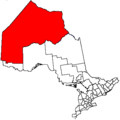Cat Lake First Nation
Cat Lake 63C | |
|---|---|
| Cat Lake Indian Reserve No. 63C | |
| Country | |
| Province | |
| District | Kenora |
| First Nation | Cat Lake |
| Area | |
| • Land | 17.04 km2 (6.58 sq mi) |
| Elevation | 404 m (1,325 ft) |
| Population (2011)[1] | |
| • Total | 489 |
| • Density | 28.7/km2 (74/sq mi) |
Cat Lake First Nation is an Ojibway First Nation reserve approximately 180 kilometres northwest of Sioux Lookout in northwestern Ontario, Canada, located on the central north shore of Cat Lake.[3] As of November 2007[update], their total registered population was 612 people, of which their on-reserve population was 497.
Cat Lake is policed by the Nishnawbe-Aski Police Service, an Aboriginal-based service.
History
The First Nation calls itself Bizhiw-zaaga'iganiwininiwag meaning "Men of Wild-cat Lake" or as Bizhiw-zaaga'iganiing Nitam Anishinaabeg meaning "The First Nation at Wild-cat Lake," where wild-cat refers to the Canada lynx. Community of Cat Lake was originally established as a Hudson's Bay Company trading post in 1788, and later belonged to the Osnaburgh Band of Ojibway. The Cat Lake reserve is within the boundaries of the territory described by the James Bay Treaty of 1905 — Treaty 9. The reserve was formally established on June 22, 1970. Originally 218 ha and increased to 1771 ha in 2003 under the Government of Canada's Addition to Reserve Policy,[4] the First Nation has reserved itself the Cat Lake 63C Indian Reserve. The community of Cat Lake, Ontario is located within this reserve. There are approximately 1,100 people living here.
Governance
The Electoral Council Leadership of the Cat Lake First Nation is under the Election process for 2009-11 term, Where a new Senior Executive Cat Lake First Nations Council whereby are now provided as of June 2011 are as follows; Chief - Matthew Keewaykapow - Deputy Chief - Dora Leadbeater - Head Councillor - Allen Sr Ombash Councillor - Harlen Wesley Councillor - Rueben Shakakeesic
The council is a member of the Windigo First Nations Council, a non-political regional chiefs' council. In turn, the Windigo First Nations Council is a member of the larger Nishnawbe Aski Nation, a Tribal Political Organisation which represents many of the First Nations in northwestern Ontario.
Governance History
The original governance system of the community was that based on the doodem-system, where the hereditary council was established by the families of the appropriate clans, overseen by a hereditary chief. However, the original governance structure for the Cat Lake peoples were altered with the 1905 Treaty 9, and then the Indian Act brought in other leaders from other areas as chiefs for the Cat Lake First Nation.
Transportation
Wasaya Airways and Slate Falls Airways run daily service on regular schedules to Cat Lake Airport. Winter/ice roads also connect from Pickle Lake, Ontario, via the Northern Ontario Resource Trail during the winter months, which takes an average 4 to 5 hours of travel.
Official address
Cat Lake First Nation
PO Box 81
Cat Lake, ON P0V 1J0
References
- ^ a b "Cat Lake 63C census profile". 2011 Census of Population. Statistics Canada. Retrieved 2015-05-20.
- ^ Taken from Google Earth at geographic coordinates. Accessed 2016-03-10.
- ^ a b "Cat Lake 63C". Geographical Names Data Base. Natural Resources Canada. Retrieved 2016-03-10.
- ^ Ontario's Cat Lake First Nation Acquires Reserve Lands - Indian and Northern Affairs Canada

